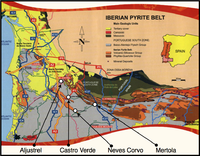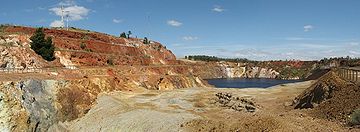
Iberian Pyrite Belt
Encyclopedia

Iberian Peninsula
The Iberian Peninsula , sometimes called Iberia, is located in the extreme southwest of Europe and includes the modern-day sovereign states of Spain, Portugal and Andorra, as well as the British Overseas Territory of Gibraltar...
, from Portugal
Portugal
Portugal , officially the Portuguese Republic is a country situated in southwestern Europe on the Iberian Peninsula. Portugal is the westernmost country of Europe, and is bordered by the Atlantic Ocean to the West and South and by Spain to the North and East. The Atlantic archipelagos of the...
to Spain
Spain
Spain , officially the Kingdom of Spain languages]] under the European Charter for Regional or Minority Languages. In each of these, Spain's official name is as follows:;;;;;;), is a country and member state of the European Union located in southwestern Europe on the Iberian Peninsula...
. It is about 250 km long and 30–50 km wide, running northwest to southeast from Alcácer do Sal
Alcácer do Sal
Alcácer do Sal is a municipality in Portugal, located in Setúbal District. It has a total area of and a total population of 13,624 inhabitants.-History :-Earliest settlement:...
(Portugal) to Sevilla (Spain). The mining
Mining
Mining is the extraction of valuable minerals or other geological materials from the earth, from an ore body, vein or seam. The term also includes the removal of soil. Materials recovered by mining include base metals, precious metals, iron, uranium, coal, diamonds, limestone, oil shale, rock...
activity in this region goes back thousands of years.
Formation
The Iberian Pyrite Belt was formed 350 million years ago in the DevonianDevonian
The Devonian is a geologic period and system of the Paleozoic Era spanning from the end of the Silurian Period, about 416.0 ± 2.8 Mya , to the beginning of the Carboniferous Period, about 359.2 ± 2.5 Mya...
Period, connected to active and hydrothermal volcanism that led to the formation of a volcanic-sedimentary complex. Volcanic activity in the region led to eight giant volcanogenic massive sulfide ore deposit
Volcanogenic massive sulfide ore deposit
Volcanogenic massive sulfide ore deposits are a type of metal sulfide ore deposit, mainly Cu-Zn-Pb which are associated with and created by volcanic-associated hydrothermal events in submarine environments....
s (VMS) associated with polymetallic massive flanks of volcanic cones in the form of pyrite
Pyrite
The mineral pyrite, or iron pyrite, is an iron sulfide with the formula FeS2. This mineral's metallic luster and pale-to-normal, brass-yellow hue have earned it the nickname fool's gold because of its resemblance to gold...
, and also chalcopyrite
Chalcopyrite
Chalcopyrite is a copper iron sulfide mineral that crystallizes in the tetragonal system. It has the chemical composition CuFeS2. It has a brassy to golden yellow color and a hardness of 3.5 to 4 on the Mohs scale. Its streak is diagnostic as green tinged black.On exposure to air, chalcopyrite...
, sphalerite
Sphalerite
Sphalerite is a mineral that is the chief ore of zinc. It consists largely of zinc sulfide in crystalline form but almost always contains variable iron. When iron content is high it is an opaque black variety, marmatite. It is usually found in association with galena, pyrite, and other sulfides...
, galena
Galena
Galena is the natural mineral form of lead sulfide. It is the most important lead ore mineral.Galena is one of the most abundant and widely distributed sulfide minerals. It crystallizes in the cubic crystal system often showing octahedral forms...
and cassiterite
Cassiterite
Cassiterite is a tin oxide mineral, SnO2. It is generally opaque, but it is translucent in thin crystals. Its luster and multiple crystal faces produce a desirable gem...
. The deposits of the Iberian Pyrite Belt are notable examples of volcanic- and sediment-hosted massive sulfide (VSHMS) deposits, which hybrids between the VMS and SEDEX
Sedimentary exhalative deposits
Sedimentary exhalative deposits are ore deposits which are interpreted to have been formed by release of ore-bearing hydrothermal fluids into a water reservoir , resulting in the precipitation of stratiform ore....
deposits. Over 250 deposits are known in the belt.
Mining

Roman Empire
The Roman Empire was the post-Republican period of the ancient Roman civilization, characterised by an autocratic form of government and large territorial holdings in Europe and around the Mediterranean....
who exploited the mines with greater intensity, thanks to its strategic position in the Mediterranean. This southern area of Lusitania
Lusitania
Lusitania or Hispania Lusitania was an ancient Roman province including approximately all of modern Portugal south of the Douro river and part of modern Spain . It was named after the Lusitani or Lusitanian people...
, a Roman province
Roman province
In Ancient Rome, a province was the basic, and, until the Tetrarchy , largest territorial and administrative unit of the empire's territorial possessions outside of Italy...
for several centuries, was an abundant source of mineral ore
Ore
An ore is a type of rock that contains minerals with important elements including metals. The ores are extracted through mining; these are then refined to extract the valuable element....
which included gold
Gold
Gold is a chemical element with the symbol Au and an atomic number of 79. Gold is a dense, soft, shiny, malleable and ductile metal. Pure gold has a bright yellow color and luster traditionally considered attractive, which it maintains without oxidizing in air or water. Chemically, gold is a...
, silver
Silver
Silver is a metallic chemical element with the chemical symbol Ag and atomic number 47. A soft, white, lustrous transition metal, it has the highest electrical conductivity of any element and the highest thermal conductivity of any metal...
, copper
Copper
Copper is a chemical element with the symbol Cu and atomic number 29. It is a ductile metal with very high thermal and electrical conductivity. Pure copper is soft and malleable; an exposed surface has a reddish-orange tarnish...
, tin
Tin
Tin is a chemical element with the symbol Sn and atomic number 50. It is a main group metal in group 14 of the periodic table. Tin shows chemical similarity to both neighboring group 14 elements, germanium and lead and has two possible oxidation states, +2 and the slightly more stable +4...
, lead
Lead
Lead is a main-group element in the carbon group with the symbol Pb and atomic number 82. Lead is a soft, malleable poor metal. It is also counted as one of the heavy metals. Metallic lead has a bluish-white color after being freshly cut, but it soon tarnishes to a dull grayish color when exposed...
, and iron
Iron
Iron is a chemical element with the symbol Fe and atomic number 26. It is a metal in the first transition series. It is the most common element forming the planet Earth as a whole, forming much of Earth's outer and inner core. It is the fourth most common element in the Earth's crust...
. Given its mineral riches, the area played a significant role in the expansion of Roman metallurgy. During the Roman period, extensive mining and storage of valuable minerals required protective fortifications and mineral warehouses. There are remains of more than 20 such small structures in the Portuguese Castro Verde territory. A mining transportation route that existed between the mines
Aljustrel mine
Aljustrel mine was a zinc-lead mine near Aljustrel, Portugal. The mine was put on care and maintenance in November 2008....
of Aljustrel
Aljustrel
Aljustrel is a municipality in Portugal with a total area of 458.3 km² and a total population of 9,940 inhabitants.During the Roman era, Aljustrel was known as Metallum Vispascense....
20 km to the north and the port city of Mértola
Mértola
Mértola is a municipality in southeastern Portugal next to the Spanish border. It has a total area of 1,292.87 km² and a total population of 8,712 inhabitants . In terms of land area, it is the sixth-largest municipality in Portugal. The resultant population density of 6.74 persons/km² is the...
40 km to the east, is situated on the Guadiana river.
The Sao Domingos Mine
Sao Domingos Mine
The São Domingos Mine is a deserted open-pit mine in São Domingos, Alentejo, Portugal. This site is one of the volcanogenic massive sulfide ore deposits in the Iberian Pyrite Belt, which extends from the southern Portugal into Spain. The Romans mined in the São Domingos area for gold and silver for...
and Ríotinto mines
Minas de Riotinto
Minas de Ríotinto is a town and municipality located in the province of Huelva, southern Spain.-External links:* - Sistema de Información Multiterritorial de Andalucía* - Riotinto's website...
accounted for one of the bases of the economy in the area. While in the Middle Ages
Middle Ages
The Middle Ages is a periodization of European history from the 5th century to the 15th century. The Middle Ages follows the fall of the Western Roman Empire in 476 and precedes the Early Modern Era. It is the middle period of a three-period division of Western history: Classic, Medieval and Modern...
there was a decline in the mining industry, in the Industrial Revolution it intensified again, especially from the late nineteenth century when dozens of mines operated, primarily producing pyrite. Removal of sulfur
Sulfur
Sulfur or sulphur is the chemical element with atomic number 16. In the periodic table it is represented by the symbol S. It is an abundant, multivalent non-metal. Under normal conditions, sulfur atoms form cyclic octatomic molecules with chemical formula S8. Elemental sulfur is a bright yellow...
remained significant until the 1950s because of its application in the chemical industry (production of sulfuric acid
Sulfuric acid
Sulfuric acid is a strong mineral acid with the molecular formula . Its historical name is oil of vitriol. Pure sulfuric acid is a highly corrosive, colorless, viscous liquid. The salts of sulfuric acid are called sulfates...
). At present, this mining area is in decline. The economic viability depends on the extraction of copper, zinc, lead and, in some cases, precious metals like gold and silver. The São Domingos Mine is now a deserted open-pit pyrite mine in Alentejo, Portugal
Portugal
Portugal , officially the Portuguese Republic is a country situated in southwestern Europe on the Iberian Peninsula. Portugal is the westernmost country of Europe, and is bordered by the Atlantic Ocean to the West and South and by Spain to the North and East. The Atlantic archipelagos of the...
.

